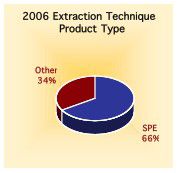Solid Phase Extraction
Solid-phase extraction (SPE) has been commercially available for over twenty years and is still finding new applications. Growth of this technique seems to be largely a function the vendors? capability to provide specific application support, especially in clinical sciences, pharmaceuticals, toxicology, pesticides and residues analysis.
Solid-phase extraction (SPE) has been commercially available for over twenty years and is still finding new applications. Growth of this technique seems to be largely a function the vendors' capability to provide specific application support, especially in clinical sciences, pharmaceuticals, toxicology, pesticides and residues analysis.

2006 Extraction Technique Product Type
The market can be segmented into three product types: automated, non-automated systems, and related aftermarket products. Non-automated systems are assemblies of hardware products that are used in combination with SPE columns, plates and disks. These products include vacuum pumps, manifolds and evaporation systems, which require little if any maintenance and are easy to operate and set-up. Due to the relatively low cost, they are utilized primarily in labs with low throughput requirements and thus cannot justify the purchase of an automated system.
Automated systems are somewhat expensive ranging from $25,000 to $100,000, but are perhaps the most practical solution when preparing a large number of samples. Many automated SPE systems are liquid handling stations, which are often used to satisfy high throughput requirements of combinatorial chemistry, drug discovery and development laboratories. Other automated SPE systems have the ability to directly inject purified and concentrated samples into an HPLC, GC, MS or NMR system for online SPE automation.
SPE, however, is primarily performed without the use of fancy equipment. In most cases, its ease of use, inexpensiveness, and disposability, make manually operated SPE cartridges, discs, and plates preferable to automated systems. Cartridges are the most popular format having a broader selection of solid phases than discs and plates. Discs are slightly more expensive than cartridges, but offer the ability to accommodate higher flow rates, which is advantageous in many environmental applications.
SPE is the largest segment in the general spectrum of extraction techniques such as soxhlett/liquid liquid extraction (LLE), accelerated/pressurized solvent extraction (ASE/PSE) and supercritical fluid extraction (SFE), accounting for over two thirds of the market demand. SPE is heavily used in pharmaceutical labs in addition to hospital/clinical and contract research/organization laboratories.
The foregoing data was extracted and adapted from SDi's Global Assessment Report, 9th Edition. For more information, contact Glenn Cudiamat, VP of Research Services, Strategic Directions International, Inc., 6242 Westchester Parkway, Suite 100, Los Angeles, CA 90045, (310) 641-4982, fax: (310) 641-8851, e-mail: cudiamat@strategic-directions.com
The Next Frontier for Mass Spectrometry: Maximizing Ion Utilization
January 20th 2025In this podcast, Daniel DeBord, CTO of MOBILion Systems, describes a new high resolution mass spectrometry approach that promises to increase speed and sensitivity in omics applications. MOBILion recently introduced the PAMAF mode of operation, which stands for parallel accumulation with mobility aligned fragmentation. It substantially increases the fraction of ions used for mass spectrometry analysis by replacing the functionality of the quadrupole with high resolution ion mobility. Listen to learn more about this exciting new development.
The Complexity of Oligonucleotide Separations
January 9th 2025Peter Pellegrinelli, Applications Specialist at Advanced Materials Technology (AMT) explains the complexity of oligonucleotide separations due to the unique chemical properties of these molecules. Issues such as varying length, sequence complexity, and hydrophilic-hydrophobic characteristics make efficient separations difficult. Separation scientists are addressing these challenges by modifying mobile phase compositions, using varying ion-pairing reagents, and exploring alternative separation modes like HILIC and ion-exchange chromatography. Due to these complexities, AMT has introduced the HALO® OLIGO column, which offers high-resolution, fast separations through its innovative Fused-Core® technology and high pH stability. Alongside explaining the new column, Peter looks to the future of these separations and what is next to come.
Liquid Chromatography to Analyze Vitamin D Proteins in Psoriasis Patients
January 21st 2025Can a protein involved in delivering Vitamin D to target tissues have an altered serum profile in psoriasis patients with cardiovascular disease? Researchers used liquid chromatography (LC) to help find out.
